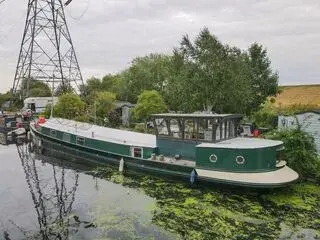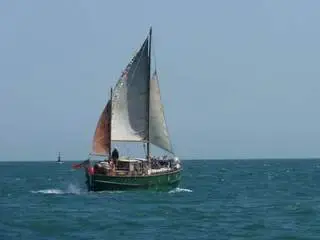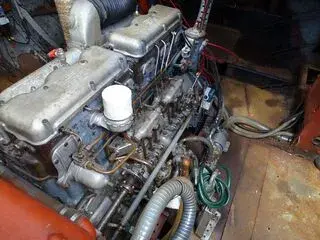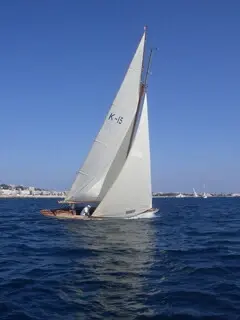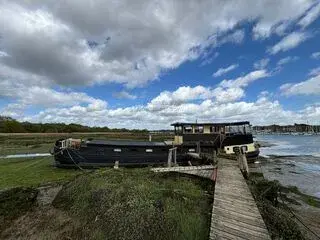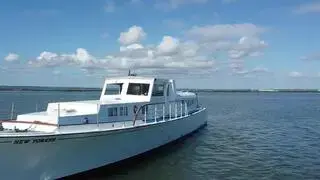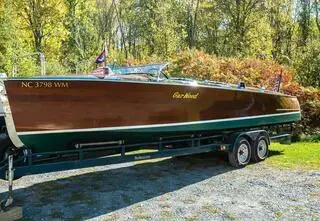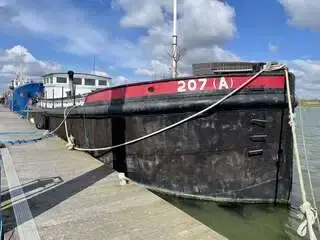Launched as a Baltimore Class Lifeboat in 1921, she served in Wick and then Amble until 1952 in which time she saved 98 lives. Bought by the present owner in 1965, she was converted to her present arrangement in a major refit which was completed in 1970. She has a very large and safe cockpit with a gaff ketch rig, Perkins 100hp diesel giving 10 knots and a comfortable interior with 7 berths including a separate double owners cabin. A very unusual boat and although not fast, she is a very safe, reliable and stable platform with masses of space on deck and down below.
SpecsBuilder: S.E. Saunders, Isle of Wight
Designer: Watson
Flag of Registry: United Kingdom
Keel: Full
DimensionsLOA: 45 ft 0 in
Beam: 12 ft 6 in
LWL: 44 ft 0 in
Length on Deck: 45 ft 0 in
Minimum Draft: 3 ft 6 in
Maximum Draft: 3 ft 6 in
EnginesTotal Power: 100 HP
Engine 1:
Engine Brand: Perkins
Year Built: 1965
Engine Model: S6M 6cyl
Engine Type: Inboard
Engine/Fuel Type: Diesel
Propeller: 3 blade propeller
Drive Type: Direct Drive
Engine Power: 100 HP
Cruising Speed: 6 knots
Maximum Speed: 10 knots
TanksFresh Water Tanks: 1 (60)
Fuel Tanks: 1 (100)
AccommodationsNumber of single berths: 5
Number of double berths: 2
Number of cabins: 1
Number of heads: 1
ElectronicsCompass - Henry Browne
GPS - MLR FX321
Depthsounder - NASA Target 2
Log-speedometer
VHF - Sealine 11
SailsBattened mainsail
Genoa
RiggingSteering wheel
Inside EquipmentOven - Flavel 2 burner gas stove with oven and grill.
Fresh water maker - manual pumped
Marine head - Jabsco sea toilet which discharges directly overboard.
Battery charger - 4 x 12 volt domestic batteries. 2 x 12 volt engine start batteries. Charged from engine alternator.
Refrigerator - 12 volt fridge under the work surface.
Manual bilge pump - 2 + engine pump
Outside Equipment/ExtrasManual windlass
Converted Baltimore Class LifeboatWooden Ships Comments on this Converted Baltimore Class Lifeboat
Built by S.E. Saunders of Cowes for the RNLI in 1921, known as the Baltimore Class life boat, a sailing life boat with auxiliary power. Launched as the Frederick and Emma, her first station was Wick where she served until 1939, after which she went to Amble until 1952. During her time in service she saved 98 lives.
Bought by the present owner in 1965 as a bare hull, he fitted her out with the new deck and coachroof arrangement, new engine, rig and interior fit out, she was then used as a live aboard for many years and then as a family yacht, cruising the east coast and taking part in the traditional regattas. Although never at the front of the fleet, she was always there no matter what the weather.
Vessels like this are unusual in their shape and conversion has to be done in a clever way in order to maximise the space available. The owner of this boat has managed to fit in an enormous cockpit which is very deep and safe, plus an interior with 7 berths and what feels like a lot of space. The deck space is vast as well, despite the large coachroof, with ample room to move around and work the rig from.
The sailing performance is not her strong point, she needs a good wind to get going as expected but will carry her canvas into very heavy weather and will look after her crew through anything. The strength, weight and stability of a vessel like this mean there is more to her than simple speed and performance.
Length on Deck 45′
Beam 12’6″
Draft 3’6″
Gross tonnage 15.26
Construction
Planked in double diagonal Honduras mahogany fastened together with copper rivets.
Heavy oak frames at 30″ centres fastened with copper.
Solid teak back bone with heavy iron strap floors.
Deck is 3/4″ marine plywood, sheathed externally and painted in deck paint.
High toe rail all round set on the galvanised stanchion bases.
1.5″ Honduras mahogany coachroof coamings with a sheathed plywood coachroof deck
Large self draining cockpit with seating either side and vast lockers beneath.
Thick cork rubbing band all round is a throwback to her working life and gives stability in heavy weather.
Rig
Gaff ketch rig on solid deck stepped masts.
Solid varnished wooden booms and gaffs.
Well oiled galvanised standing rigging to internal galvanised steel chain plates.
Tough mainsail and mizzen made by James Lawrence, approximately 50 years old in good condition.
Staysail, genoa and mizzen staysail in terylene.
Machinery
Perkins 56M 100hp 6cyl diesel installed new in 1965.
MR10A gearbox with single lever controls to a large fixed 3 blade bronze propeller in a tunnel as with most RNLB’s.
6 knots cruising speed, 10 knots max. 1 gallon/hour at cruising speed.
100 gallon steel fuel tank under cockpit sole
60 gallon galvanised steel water tank under saloon sole.
4 x 12 volt domestic batteries. 2 x 12 volt engine start batteries. Charged from engine alternator.
2 manual bilge pumps and an engine driven bilge pump.
Accommodation
Fitted out by the present professional shipwright owner when he first bought the boat.
Maximum of 7 berths with a large double owners cabin.
Step down from the cockpit into a passageway offset to starboard past the engine space.
Starboard pilot berth in the passageway under the deck head. Large chart desk and storage area on top of the engine box.
Forward into the main saloon, very wide open space with ample headroom. Single settee berth to starboard. Double settee berth to port. Dropleaf saloon table in the centre.
Forward into the galley with a Flavel 2 burner gas stove with oven and grill. Work surface either side with stowage for crockery and shelves above. 12 volt fridge under the work surface.
Starboard side is a large work surface area with a single stainless sink with manually pumped fresh water.
Forward into the forepeak with lots of stowage, bosuns stores and a single berth to port if required.
The owner’s cabin is on the port side of the engine box, accessed through a passage to port at the base of the companion steps. Large double berth when folded down with full standing headroom.
Heads compartment is at the entrance of the owner’s cabin with a Jabsco sea toilet which discharges directly overboard.
Full specification and details available upon request
Disclaimer:
These particulars have been prepared in good faith from information provided by the Vendors and are intended as a guide, Wooden Ships cannot guarantee or warrant the accuracy of this information nor warrant the condition of the vessel. The Purchaser should instruct his agent or surveyor to validate all details as necessary and satisfy himself with the condition of the vessel and its equipment.
